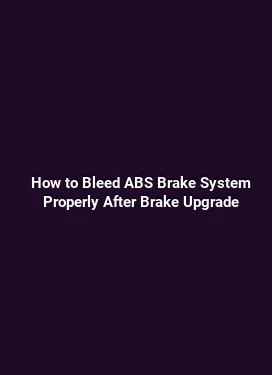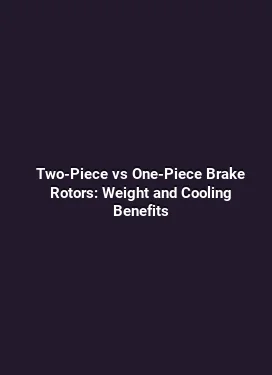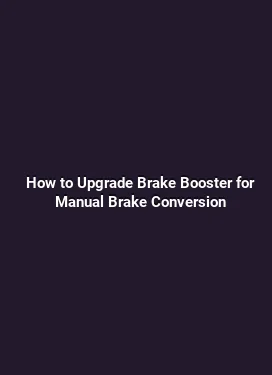Best BBK for Daily Driven Modified Cars: Quiet and Low Dust Options
For enthusiasts who blend daily usability with weekend edge, upgrading to a big brake kit (BBK) can dramatically improve stopping power, fade resistance, and overall driving confidence. The challenge lies in choosing components that balance performance with everyday comfort: minimal noise, reduced dust, predictable pedal feel, and compatibility with street tires and common road conditions. This guide dives into the essential considerations for selecting a BBK that remains quiet and low-dust under regular commuting, while still delivering the heat management and bite expected from a high-performance setup.
The Case for BBK in Daily-Driven Modified Cars

Big brake kits replace factory components with larger rotors, multi-piston calipers, and specialized pads. The core benefits include greater heat capacity, improved pad bite, and more consistent braking under repeated use. For daily drivers with modified engines or suspension, a BBK can mitigate brake fade on long hill descents or spirited drives. However, without careful selection, the additional mass, rotor surface area, and pad chemistry can introduce brake dust, noise, or street-ride harshness that annoys daily commuting routines.
Key considerations include rotor material and design, caliper configuration, pad chemistry, and how the system integrates with the vehicle’s ABS, wheel fitment, and street tires. A thoughtful approach looks at real-world usage patterns: daily acceleration profiles, stop-and-go city traffic, highway braking, and occasional track or autocross sessions. It is also important to account for rotor wear rates, heat soak behavior, and the potential need for upgraded lines and fluid compatible with higher temperatures.
Core Components: Rotors, Calipers, and Pads in Daily-Driven Scenarios
Rotors form the heat sink of any BBK. Larger diameters and thicker rotors increase cooling capacity but also add rotational mass. In daily driving, a balance is essential: enough mass to manage heat but not so much that pedal effort or unsprung weight disrupts ride quality. Vented, drilled, or slotted rotors each bring distinct advantages and trade-offs. For many street-oriented kits, high-quality vented rotors with optimized vane patterns provide steady performance without excessive noise or dust.
Caliper architecture influences bite, modulation, and noise. Multi-piston designs (six-piston, eight-piston, etc.) distribute clamping force for more even pad wear and improved stopping power at lower pedal travel. However, a heavier caliper can alter steering feel and unsprung weight. In daily use, the goal is to achieve consistent bite with manageable pedal effort, while avoiding harsh engagement that can aggravate ride quality on rough pavement.
Pad choice is a major driver of both dust and noise. The chemistry determines cold friction, wear rates, and sound during engagement. For quiet operation and low dust, seek compounds engineered for street use with reduced abrasive content, or formulations that emphasize low dust and low noise while maintaining strong bite at operating temperatures. Some modern pad families employ ceramic or semi-metallic blends that offer a smoother engagement curve and cleaner caliper tracking, which translates to less visible brake dust on wheels and quieter operation during low-speed braking.
Quiet and Low-Dust Pad Technologies: What to Look For
In the realm of daily driven modified cars, pad technology matters as much as rotor design. You want a pad that remains effective in cold weather, generates minimal dust, and avoids squeal or chatter at typical city speeds. Look for compounds labeled as low-dust or low-noise, and check traction data such as peak friction and pad wear rate under street operating temperatures. It is also wise to verify that the pad material is compatible with your rotors and calipers to prevent glazing or noise-conditioned corners.
Noise and dust are not solely a function of pad chemistry. The pad-to-rotor interface, rotor finish, and caliper alignment all influence these factors. A proper rotor surface finish, clean lug surfaces, and correct caliper alignment reduce the risk of pad chatter, squeal, or uneven wear. In daily use, a quiet BBK pad will minimize nuisance sounds during light brake application and low-speed deceleration, while still providing dependable stopping power when it counts.
Pad Material Choices for Daily Driving

Ceramic-based or ceramic-enhanced pads often offer the quietest operation and the lowest dust production, making them popular in street-driven setups. They typically exhibit stable friction across a broad temperature range and create less particulate matter on wheel faces. Semi-metallic pads, while offering strong initial bite and high-temperature performance, can produce more dust and noise if not matched properly with rotor and caliper geometry. For daily-driven modified cars, a well-chosen ceramic or ceramic-like pad combined with an optimized rotor finish can strike a favorable balance between performance and everyday usability.
Dust Reduction Through Rotor Finish and Design
Rotor finish plays a subtle yet important role. A smooth, well-lapped rotor face reduces uneven pad wear, which can contribute to noise and dust when pads engage irregularly. Some BBKs feature rotors with optimized vane patterns and coatings designed to resist glazing and maintain consistent contact with the pad. Even with low-dust pads, a rotor that minimizes uneven wear behaviour supports cleaner wheels and steadier braking feel across daily usage patterns.
Choosing the Right BBK Size for Daily Driving Habits
BBK sizing is more nuanced than selecting the largest option available. The goal is to match rotor diameter, rotor thickness, and caliper count to your daily load and tire size. A larger rotor diameter can lower braking temperatures and increase thermal capacity, but it also increases pedal travel, mass, and potential fitment constraints. For most daily-driven modified cars, a mid-to-larger diameter rotor paired with a multi-piston caliper that maintains a comfortable pedal feel offers a practical middle ground. In high-load situations such as frequent mountain descents or spirited canyon runs, a kit with superior cooling capacity and a robust pad compound remains advantageous.
Wheel and tire compatibility is essential. Larger BBKs can require spacers or caliper relocation, and some wheel designs may not clear thick rotors. Ensure that your wheels have enough clearance for caliper width and that there is adequate air gap to promote cooling. A precise rotor-to-hub finish and solid mounting hardware also contribute to consistent performance over time and reduce the risk of rotor runout, which can manifest as pulsation or uneven braking in daily use.
Brake Fluid, Lines, and System Integrity
Upgrading to a BBK often necessitates refresher maintenance on ancillary components. High-temperature brake fluid with a proper boiling point protects against pedal fade under repeated braking. Stainless steel braided lines can provide a more consistent pedal feel, though their impact on daily comfort depends on vehicle weight, suspension tuning, and road surface quality. For daily driving, the aim is a predictable and linear pedal response that remains stable from cold starts to extended freeway braking sessions.
Bleed procedures and proper bedding-in (the process of seating the pads to the rotors) are critical for achieving the full potential of a BBK. A methodical bedding-in routine reduces cold bite variability and supports even pad wear, contributing to quieter operation and reduced dust generation over time. If possible, follow the manufacturer’s bedding guidelines and perform a controlled bed-in on a safe, open road or a dedicated test area, avoiding abrupt stops during the initial bedding period.
Real-World Scenarios: How the Right BBK Improves Daily Driving
Consider a daily-driven sports sedan with a modified exhaust note, larger wheels, and a spirited weekend schedule. A BBK chosen for quiet operation can offer ample bite during city cruising and highway ingress, while the low-dust pads keep wheel faces cleaner between wash days. For a compact performance hatch used in urban driving, a compact BBK with a low-dust ceramic pad can deliver consistent performance in stop-and-go traffic and provide a reassuring pedal feel when approaching traffic lights after a long stretch of freeway driving.
Track days, autocross, or canyon runs add another layer of demand. A BBK with enhanced heat capacity and robust rotor cooling helps prevent fade and pedal firmness loss during repeated high-speed braking. In such cases, pairing high-temperature brake fluid and properly sized rotors ensures the system can sustain performance without a dramatic rise in brake dust or noise on the street edition of the car.
Installation, Maintenance, and Long-Term Ownership
The installation process for BBKs varies by vehicle model and kit specification. Adhering to torque specifications, ensuring proper rotor runout, and using correct fastening hardware are essential steps. If a professional installation is not an option, study the kit’s installation manual carefully and verify compatibility with your vehicle’s ABS sensor placement, wheel speed sensor routing, and brake line routing. After installation, perform a thorough system bleed and bed-in procedure to maximize performance and minimize noise and dust generation during the initial weeks of use.
Maintenance intervals may shift with a BBK. Inspect rotors for signs of wear, glazing, or hot spots, and check caliper pistons for smooth operation. Pad wear should be monitored and replaced before the pad thickness approaches the minimum specification, as worn pads can contribute to rotor scoring and noise. Regular wheel cleaning, especially in areas with high dust exposure, helps prevent build-up that could mask underlying issues and make noise diagnosis more difficult.
Trend Keywords and Semantics: What Car Enthusiasts are Looking For
In the current landscape, enthusiasts seek terms that reflect both practical outcomes and aspirational performance. Phrases focusing on quiet operation, low-dust pads, and balanced daily usability are prevalent. Semantically related concepts include thermal management, pedal feel consistency, rotor cooling efficiency, material science behind pad formulations, and the interplay between brake system upgrades and overall vehicle dynamics. When evaluating BBKs, readers often compare weight, cost, ease of installation, and real-world feedback from other drivers with similar usage patterns.
Getting the most value from a BBK is about harmonizing components to the driving context. A well-matched kit considers rotor diameter, caliper torque, pad material, wheel clearance, and how the upgrade integrates with existing braking hardware. The result should be a more confident daily drive with predictable braking performance, reduced maintenance nuisance, and a cleaner wheel appearance due to diminished dust deposition.
Practical Guidance for Selecting a BBK That Feels Right on the Street
Start by defining daily usage patterns: city traffic, highway mileage, occasional long descents, and any planned performance events. Use this framework to narrow options to kits that emphasize quiet operation and low dust, and then evaluate performance data such as cold bite, fade resistance, and pad wear rates under expected operating temperatures. Consultation with technicians or experienced owners who tune similar vehicles can provide insight into real-world reliability and ongoing maintenance considerations.
Budget constraints are a reality, but allocating funds toward a balanced system often yields the best long-term satisfaction. A kit that is capable, matching wheel clearance and suspension compatibility, with proven quiet and low-dust credentials, tends to deliver the most consistent daily performance without requiring frequent wheel cleaning or audio compromises during normal driving.
Maintaining Quietness and Cleanliness Over Time
Factory-style braking balance may shift slightly after a BBK installation due to weight distribution changes. Periodic alignment checks and, if needed, light suspension tuning help maintain steering feel and stability. Keeping wheels free of brake dust during routine washes not only improves aesthetics but also makes it easier to inspect the braking system for any anomalies. Routine checks of pad wear, rotor condition, and line integrity help sustain quiet operation and prevent unexpected noises or dust spikes.
In summary, the best BBK for a daily driven modified car prioritizes quiet, low-dust operation while delivering reliable, repeatable braking under a range of conditions. Thoughtful component matching, proper installation, and disciplined maintenance transform a performance upgrade into a smooth, confident daily experience that respects both street practicality and weekend performance aspirations.






